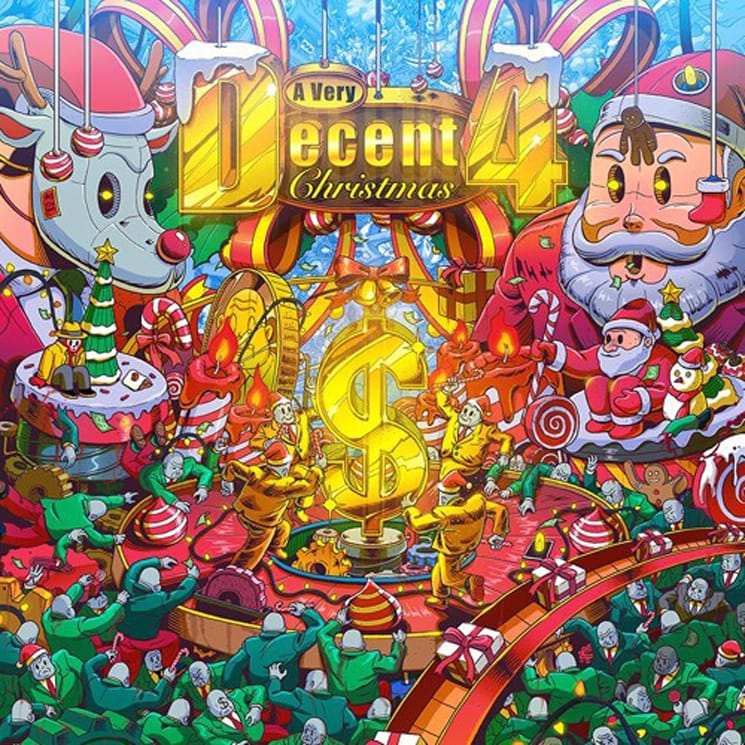Real and Imagined Malls
Where all music is Christmas music

The following is an essay about Christmas music I read in Brooklyn at Better Read Than Dead bookstore on November 16, 2019.
Though I intend to not publish anything on this blog solely examining recordings or topics concerning recorded music, I feel like this essay squeaks in because live performance is proposed as a remedy for Christmas music's woes. Having expected the essay would need a retro-fit, I’m amazed at how intact my thesis remains. The only necessary addition was a mention of country legend Brenda Lee, who is awesome. This can be read with the general assurance that, in the time since, every economic or cultural rot mentioned below has gotten moderately worse.
I'll have plenty more to come in 2024. I raise my glass of oat milk eggnog to each of you, my esteemed subscribers. Happy holidays to you and yours, free Palestine, fuck Substack, Joey Casio invented neon.
In 2007, a Providence, Rhode Island man named Michael Townsend was arrested for squatting in a shopping mall for four years. He and some friends had set up a fully-furnished studio apartment in an obscure nook of the building that was easily overlooked by staff and shoppers, and he was able to live there for intermittent periods, some as long as three weeks. Townsend had previously been evicted from a warehouse that was demolished to make room for the mall’s parking lot. The warehouse was an artist collective known as Fort Thunder. Emblematic of American DIY cultural spaces in the 2000s and loaded with colorful artwork and trash collage, Fort Thunder's best-known tenant was the drummer of noise-metal band Lightning Bolt.
Townsend said that living inside the mall was something of a revenge plot against the developers, but also an idea that somehow became more feasible the sillier it got, something very much in the Fort Thunder spirit. One day he happened to notice the corridor when passing by the construction site, and years later, he and his friends were hauling in furniture and fixtures in the middle of the business day, casually threading through the crowds with chairs and cinder blocks. For a while the plan actually worked, until Townsend was nabbed in a mall cop dragnet. When he went to court for trespassing, the judge was reportedly impressed by the elaborate nature of his effort, and Townsend’s mild misdemeanor conviction merely banned him from ever going to the mall again.
It’s a pretty funny story. Especially in a moment when it’s widely understood that brick and mortal retail is facing an existential crisis. The lineup of bankruptcies (Toys R Us, Payless, Charlotte Russe) grows larger every year. Even Sears, a multi-generational department store juggernaut. They’re all getting crushed by Amazon, of course, but they’re also getting picked apart by private equity vultures who purchase troubled stores, deploy huge layoffs and sell the real estate assets for scrap. Great swaths of the retail sector are facing what many analysts see as a ticking time bomb of debt and diminishing returns. At the same time, what could be done with all that condensed commercial real estate? Until consumer habits fully transform, the mall, as we know it, persists.
The true Achilles heel of retail is Black Friday. If you didn’t already know this, it’s called Black Friday because most stores just bleed money for the first three quarters of the year, and it’s only when the Christmas shopping season comes around that their numbers start to move from the red into the black. Prior to the proliferation of two-day shipping and Cyber Monday, Black Friday already had a bad reputation—every local news station in the country has a B-roll package of people getting trampled in the entryway of a Target. But even if you’re not willing to risk life and limb to get your cousin a pair of Airpods right after Thanksgiving, the fact remains that going to a mall or big box store at any point in the month of December is not a fun experience. Parking sucks, lines are long, and you will be inundated, like you are every year, with the cloying, dulcet tones of Christmas music. And though it does and may always induce an involuntary Pavlovian drip of nostalgia, Christmas music is no one's favorite.
I am fascinated by it. So much of it is immediately recognizable as Christmas music, but determining the exact contours of the genre feels very slippery. Certain subject matter (Santa, the newborn king) are very easily shelved, and a lot of it is secular, seasonal odes to snow and roaring fires. Yet somehow it’s verboten to play these songs in January. It doesn’t have any singular instrumental signifiers, besides maybe sleigh bells, and while many songs are as serious and solemn as a fad dance number, they have endured for decades.
I’m mostly fascinated by Christmas music’s predicament. Just like the shopping centers that pipe it over the loudspeakers every year, Christmas music as we know it is facing a slow terminal decline. The canon of Christmas music is not replenishing itself, and if the charts are any indication, there doesn't appear to be any incentive to try. The resurrection and growing popularity of Mariah Carey’s “All I Want for Christmas is You”, released 19 years ago, is no longer a meme but a replicable playbook—Brenda Lee's "Rocking Around the Christmas Tree" (released in 1958) is receiving a similar social media push. Despite artists from every corner of the pop sphere still releasing Christmas cover albums, any original songs on these records aim for little more than short-lived novelty (like on the recent Kacey Musgraves’ duet with Willie Nelson called “Have A Willie Nice Christmas”). With catalog hits showing algorithmically-rejuvenated strength, the songwriting braintrusts of New York and Nashville do not appear interested in writing new and enduring inter-generational Christmas songs. This is obviously not the most urgent art project to undertake, but it speaks to diminishing returns in the larger ecosystem.
Streaming services have such a hold on the industry that they are reshaping our listening habits, and in turn reshaping the music itself. According to Spotify’s own findings, people my age or older open the app and are likely use the search function to pull up an artist, album or song. But for many of its core users, primarily young people, the search function is an incidental feature, something they might only accidentally stumble upon. When they open the app, they cue a playlist on the homepage. And this is by design: Spotify’s user interface is playlist oriented to ensure long, passive, frictionless listening, and these playlists are largely in service of functional affect: Running Music, Studying Music, Breakup Music. Otherwise slippery taxonomies that, over time, and with the algorhythmic incentive to keep the work as familiar and inoffensive as possible, could become calcified. The New York Times pop critic Jon Caramanica has already outlined a phenomenon he calls “Spotifycore”, pop music composed with playlists in mind. The components are a genre agnostic slurry: a breathy R&B vocal, a “soft” EDM drop in the chorus, a particular timbre of hip-hop clap. A series of signifiers not unlike sleigh bells.
I fear that all popular music could meet the fate of Christmas music: flattened and maligned to mere novelty for maximum frictionless utility on a streaming platform, only evoking memory, weather, and tradition out of passive repetition, just another node of functional affect—with established hits never surrendering their market share. But for now, like Macy’s and Dillards, Christmas music, as we still know it, persists.
And so I wondered if, for the time being, Christmas music too was open for squatting.
The first place I thought to look was in the deep web chasm of vaporwave. Using slowed-down samples, disorienting plunderphonics techniques, archaic video game graphics and unabashed corporate aesthetics, vaporwave is a practice premised on the manipulation of consumerist sentimentality and ennui. Surely its practitioners would strike gold with Christmas music, the motherlode of treacle. But in the decade plus of this genre’s existence, there’s only a handful of vaporwave Christmas projects. The best I found was a compilation called It’s a Vaporwave Christmas!, released by the label Pacific Plaza, which sounds like a real or imagined shopping center. This was true for a number of the contributing artists: Twin Pines Mall, Video Fashion, Metro West. Others (Casual Corp, Scalasoft) were more like imagined private equity firms.
Nearly all of the tracks hewed to the conventions of a vaporwave microgenre called “mallsoft”. Unobtrusive easy listening timbres and samples of smooth jazz are drenched in reverb, subverting the source material by burrowing so deep into its narcotic haze as to be unsettling. Maybe, like Townsend did, these works aim to hide in plain sight, just below the listener’s consciousness, until you happen to notice, in the polygonal skymall of your mind, that one of the non-playable characters is carrying a cinder block. The effect was psychedelic, but the consumer malaise didn’t feel season-specific, only evoking the holiday through explicit lyrical references.
So what if we approached Christmas music like a private equity firm? Restructured its divisions, cut loose the dead weight, and pivoted toward more relevant offerings? It turns out that welding a few sonic signifiers to a more popular genre template doesn’t really work either. Case in point: the annual Mad Decent Christmas compilations. We can think of the label Mad Decent like Bain Capital, and we can think of label owner Diplo, our preeminent genre dilettante, as the Mitt Romney of electronic music. For the last six years, Diplo has asked a bunch of producers to put together yuletide club bangers, and nearly all of them basically amount to the Nutcracker Suite played on a swole synth patch accompanied by bass wubs and torrential sleigh bells. It all sounds as bad as it sounds, and though it’s made with cutting edge software, it does not forge a new path for Christmas music.
It helps to think about this in terms of raw material, of post-consumer waste. In this regard, Christmas music is like styrofoam. It’s almost impossible to break it down into something that you can meaningfully reshape and repurpose. You can chop and screw an old Rankin-Bass tune, but it doesn’t succeed in evoking late-capitalist hauntology, it just sounds like Christmas on codeine. You can’t repurpose classic melodies with today’s production arsenal because it just sounds like your grandma headlining at Berghain. It all still sounds inescapably corny, beyond parody, beyond hostile takeover, beyond post-ironic intervention.
But like Townsend walking past the construction site of his future home, a strategy for determining the future of Christmas music was revealed to me by accident. Back in my home state of Arizona, I joined a very short-lived punk band. We rehearsed in my bedroom, recorded a tape in our engineer’s bedroom, played our first show in that same bedroom, then hopped on a few more gigs before our singer moved to Berlin. It was all over in five months. Years later, having all scattered and then returned to Arizona for the holidays, we were asked to play a reunion show on Christmas night at the local dive bar where everyone took a respite from their families. People enjoyed it, so they asked us to do it again next year. And then again the following year.
After we passed on the offer to play our fourth yuletide reunion show, my friend Jimmy expressed his disappointment. “You guys were becoming a Christmas tradition,” he said, suggesting that perhaps our songs, none of which were about winter or the holidays, could be considered Christmas music. He and I thought about the requirements: music (secular or not) played only in a narrow seasonal window, joyfully evoking, for a very limited segment of the public, the spirit of the season. It was a thrilling realization, like my band had accidentally laid claim to a liquidated parcel of unwanted real estate. Best of all, the name of our band was MALL.
On the question of Christmas music and the emporiums where it is played, the answer is to put them both out of their misery. The mall should should be broken by defying its typical use case, and what we understand to be Christmas music should be illegible to the algorithm. In putting a new tradition where the old one used to be, any signifiers standing in the way of meaningful ritual should be abandoned. Make your own Christmas music, make a home in the mall, and continue to keep Mariah Carey in that obscure little nook of your heart where the newborn king used to rest.

